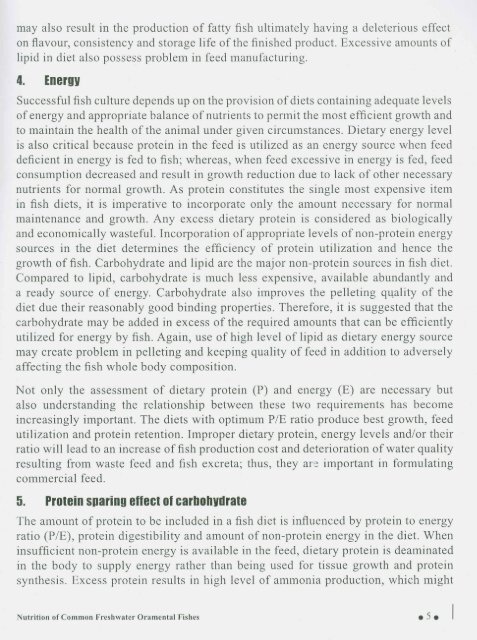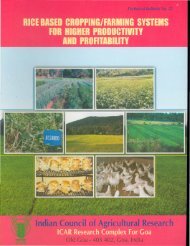Nutrition of Common Freshwater Ornamental Fishes
Nutrition of Common Freshwater Ornamental Fishes
Nutrition of Common Freshwater Ornamental Fishes
You also want an ePaper? Increase the reach of your titles
YUMPU automatically turns print PDFs into web optimized ePapers that Google loves.
may also result in the production <strong>of</strong> fatty fish ultimately having a deleterious effect<br />
on flavour, consistency and storage life <strong>of</strong> the finished product. Excessive amounts <strong>of</strong><br />
lipid in diet also possess problem in feed manufacturing.<br />
Successful fish culture depends up on the provision <strong>of</strong> diets containing adequate levels<br />
<strong>of</strong> energy and appropriate balance <strong>of</strong> nutrients to permit the most efficient growth and<br />
to maintain the health <strong>of</strong> the animal under given circumstances. Dietary energy level<br />
is also critical because protein in the feed is utilized as an energy source when feed<br />
deficient in energy is fed to fish; whereas, when feed excessive in energy is fed, feed<br />
consumption decreased and result in growth reduction due to lack <strong>of</strong> other necessary<br />
nutrients for normal growth. As protein constitutes the single most expensive item<br />
in fish diets, it is imperative to incorporate only the amount necessary for normal<br />
maintenance and growth. Any excess dietary protein is considered as biologically<br />
and economically wasteful. Incorporation <strong>of</strong> appropriate levels <strong>of</strong> non-protein energy<br />
sources in the diet determines the efficiency <strong>of</strong> protein utilization and hence the<br />
growth <strong>of</strong> fish. Carbohydrate and lipid are the major non-protein sources in fish diet.<br />
Compared to lipid, carbohydrate is much less expensive, available abundantly and<br />
a ready source <strong>of</strong> energy. Carbohydrate also improves the pelleting ql.tality <strong>of</strong> the<br />
diet due their reasonably good binding properties. Therefore, it is suggested that the<br />
carbohydrate may be added in excess <strong>of</strong> the required amounts that can be efficiently<br />
utilized for energy by fish. Again, use <strong>of</strong> high level <strong>of</strong> lipid as dietary energy source<br />
may create problem in pelleting and keeping quality <strong>of</strong> feed in addition to adversely<br />
affecting the fish whole body composition.<br />
Not only the assessment <strong>of</strong> dietary protein (P) and energy (E) are necessary but<br />
also understanding the relationship between these two requirements has become<br />
increasingly important. The diets with optimum PIE ratio produce best growth, feed<br />
utilization and protein retention. Improper dietary protein, energy levels andlor their<br />
ratio will lead to an increase <strong>of</strong>fish production cost and deterioration <strong>of</strong> water quality<br />
resulting from waste feed and fish excreta; thus, they are important in formulating<br />
commercial feed.<br />
5. Protein sparing effect <strong>of</strong> carbohydrate<br />
The amount <strong>of</strong> protein to be included in a fish diet is influenced by protein to energy<br />
ratio (PIE), protein digestibility and amount <strong>of</strong> non-protein energy in the diet. When<br />
insufficient non-protein energy is available in the feed, dietary protein is de aminated<br />
in the body to supply energy rather than being used for tissue growth and protein<br />
synthesis. Excess protein results in high level <strong>of</strong> ammonia production, which might



